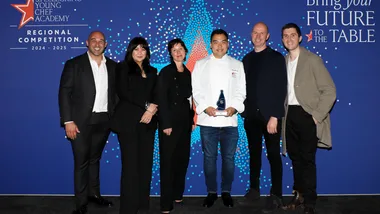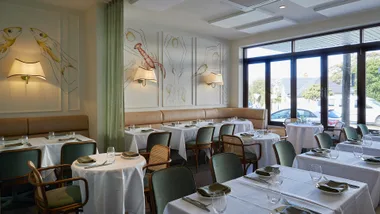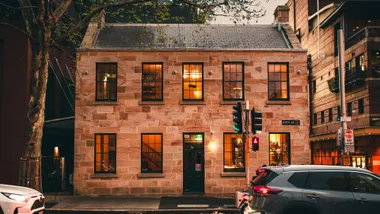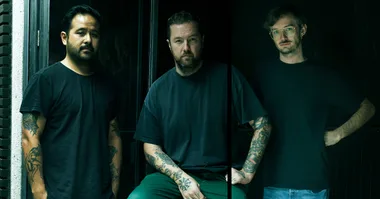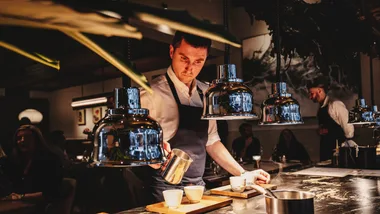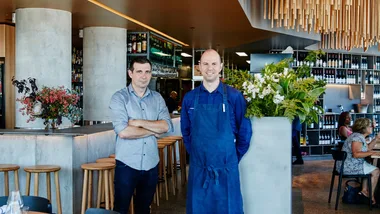The first thing I see when I look at White Heat now is my son. When I look at the front cover, or the picture of me with the fag in the mouth, I see my son Luciano. He’s now working in the kitchen with the El Bulli boys in Barcelona after finishing a year in London with Pierre Koffmann, my old boss. The other thing I see in a lot of these pictures is myself saying “taste, taste, taste, taste”. Teach them your palate, not theirs.
White Heat did 15,000 copies. But a lot of bookshops wouldn’t stock it because they didn’t think it would work. They thought it was a coffee-table book for a small section of the market. What was interesting was that, within 10 days of it being launched, it sold out. Every single year since 1990, it’s been reprinted. It’s never been on the discount shelf.

Cover of White Heat
We were shooting this in what would’ve been called the “yuppie” time: the bull market and Thatcher’s England. We were a little hole in the wall in the middle of nowhere – you had to go over bridges – and we had the most glamorous crowd in all of England. We had royals from all over Europe, from further afield, from Jordan, the Sultan of Brunei – all of them. It was an extraordinary time, and it all happened very quickly.
The pictures for the book were taken in 1987 when I was at Harveys in London. I worked seven days a week back then, and it’s a bit of a blur, but this book has fixed some of those moments in time. Looking at some of these pictures of us in service, I can still feel it, see it moving.
Bob Carlos Clarke, the photographer, would come for service in the evenings for the most part. He wasn’t that excited about photographing the mise-en-place. Bob took his inspiration from Don McCullin’s pictures of Vietnam, and decided to shoot it on 35mm film to give it that grainy texture. He looked at the kitchen like it was a war zone. He couldn’t believe the military precision during service. But then all the madness as well. That combination of being disciplined, but also the massive pressure. He was clever, was Bob.

Marco Pierre White prepping scallops
In a strange sort of way, that was still a very old-fashioned kitchen. Kitchens today are quite sophisticated. They’ve got extractor fans, they’ve got air-conditioning, they’ve got all this smart machinery. This room is tiny. A hole in the wall. And when you’ve got a tiny kitchen like that, the energy is like nothing else. I ended up with 30 in an enormous kitchen at one stage later on, and in that situation you just put the orders through and everything comes together slowly. Or at least it feels like it. If you imagine flying a plane and you’re 2,000 feet up, you still feel like you’re going slowly, but then when you’re 10 feet off the ground it speeds up – you have that same feeling of speed and concentration in a small kitchen.
We used to call the way we worked the Wolf Pack. A table of four would order and we’d all do the starter together – four of us would work on a plate each. It was the only way you could deliver very high-quality food with very few hands, and deliver it fast. If you were in a bigger kitchen, you might have three on the fish, three on the meat, with everyone working separately. We didn’t have fish, meat, entrée, garde manger and so on; it’s just bang, bang, bang. The great thing about that is that the cooks learn a lot very quickly. They have to cook everything.

Inside White Heat
When I see the picture of me prepping the scallops, I see the thickness of my arms and think, wow – it highlights just how physically demanding the job was. I flick through it and it’s so tactile and so beautiful, the way Bob caught the beauty of pasta or bread. When you’re working with it every day, you don’t always see it for yourself. The food photography looks out of date now, but if you took the woodcock with red wine sauce and changed the crockery, you’d still chop it up the same way. A lot of my philosophies and beliefs are exactly the same as they were years ago. I think the more you do to food the more you take away from it. And I’m a classicist. I’m not interested in peculiar flavours and strange combinations. They don’t do it for me. I like my escalope of salmon with sorrel sauce. I like my beef with ceps. I like my stuffed pig’s trotter with sweetbreads and morels. I like my chicken with vin jaune and mushrooms. I like basil and tomatoes, I like salt and vinegar. It works.
As far as I’m concerned, you can’t be a top chef and have a life. It’s impossible. If you’re at the highest level, like I was, I’d be at work at seven o’clock in the morning when my sons were still sleeping, and I’d get home after 12 and they were in bed. I’d be at work 20 hours some days. I believe that if you’ve got two or three stars, you have to be behind your stove.
Is it worth it? Yes. Of course it is. But there’s always a price. Had I not made those sacrifices, I’d not be the man I am today. Winning those stars is the most exciting game on earth. But retaining them is the most boring job in the world. I stopped enjoying it. When you’ve got three stars, you can’t be creative. You’re a slave to people’s demands and expectations and to your specialities.

Marco Pierre White, the day after receiving two Michelin stars
I woke up one day and realised I wasn’t happy. I gave myself three options. Option one: continue to do your six days a week, 100 hours a week. You don’t see your children but you have this amazing status. Option two: live a lie, pretend you cook when you don’t cook, question your integrity and everything you stood for. Continue to charge high prices, even when you’re not in the kitchen. Option three: pluck up the courage, hang up your apron and walk away, and accept tomorrow you’ll be unemployed and without status. Pretty interesting options, aren’t they? And on Monday morning, the 23rd of December 1999, I told Michelin I was handing back my stars. And I think that’s why the industry respects me today. Because I didn’t live a lie. You can stray from the stove, but I stayed close to the flame.
You’ve seen the picture in White Heat of the chef with the back cut out of his jacket after he complained it was too hot in the kitchen? His name is Jason Everett. He still works with me today. He doesn’t complain about the heat any more.
I think some good came out of this book. It inspired a lot of young people to come into the industry, many of them from outside the blue-collar world. I did my bit.
The shot with me holding the cleaver on the cover of the most recent edition of White Heat was taken in Bob’s studio, but the famous one of me with the fag was taken after service at the restaurant. It was the day after I’d won two Michelin stars. Some people might disagree with me, but I think that is one of the most iconic shots ever taken of a chef. It’s dirty, it’s sweaty, my jacket was drenched, every inch of it soaked. That image says: I am giving you everything I have to give.
Marco Pierre White hosted Hell’s Kitchen Australia on Channel Seven.

